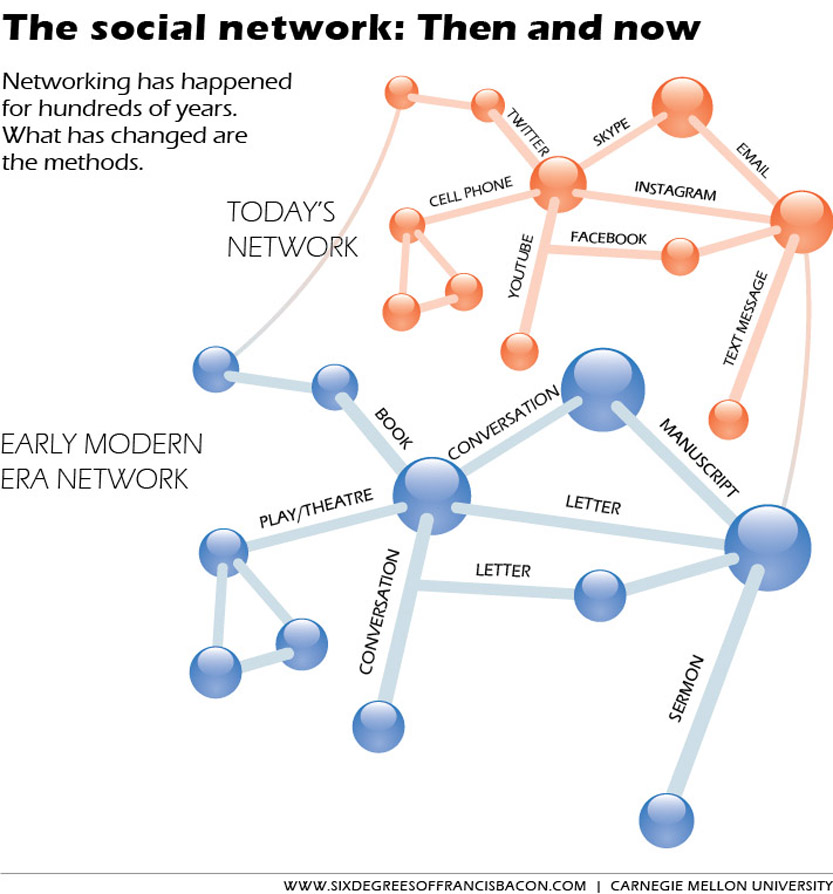Six Degrees of Francis Bacon
Carnegie Mellon Project Mines Early Modern Social Network
Contact: Shilo Rea / 412-268-6094 / shilo@cmu.eduPITTSBURGH—What if Sir Francis Bacon had been able to "friend" William Shakespeare on Facebook? The famous scientist and researcher's interactions with the playwright would have created a digital imprint for all to see, giving their other networked friends and peers insights into their relationship.
It also may have left behind evidence of one of the largest questions in all of English literature: Did Bacon or someone else write some of Shakespeare's plays?
To precisely trace the influence and ideas of Bacon, Shakespeare, Isaac Newton and more than 6,000 others from the early modern period — 16th-17th centuries — researchers at Carnegie Mellon University have created the Six Degrees of Francis Bacon project. The living project will allow scholars and students from around the world to reassemble the era's networked culture. It pulls together centuries of books, articles, documents and manuscripts that have been scattered and divided in order to understand the role of linked connections in spreading ideas and knowledge.
"Dense accounts exist of small groups and communities, giving us partial views of the early modern network, but this is the first attempt to bring it together in one place, in a visual way," said Christopher Warren, assistant professor of English in the Dietrich College of Humanities and Social Sciences. "Six Degrees of Francis Bacon is many things, but above all it's a tool for asking questions. It allows people to click on this historical network to see who's connected, recreating this whole world and then raising even more questions about how an idea, say, religious toleration, or the circulation of blood, got from person A to person B, why it took this route and not that route, and so on."
Warren added, "Francis Bacon may not have 'liked' or commented on a Facebook post by Shakespeare, but reassembling the early modern social network gets us a long way toward understanding what he or anyone else could have known, jokes and references they would have understood, sensitive information they might have encountered."
The project, which has support from a Google Faculty Research Award, uses data mining to develop the visual social network. Crawling through sources to create an initial list of 6,000 people from the period, the project already has investigated more than 19 million potential connections.
To make the massive recreation work, Warren is tapping into CMU's Department of Statistics expertise. Cosma Shalizi, associate professor of statistics, Mike Finegold, visiting assistant professor of statistics, and Ph.D. student Lawrence Wang are developing algorithms to predict who is part of any social network and probably sub-networks. They've also built the database to allow scholars who have studied these networks to add their input to increase accuracy and help them refine the algorithms.
"With such big numbers, it wasn't feasible to begin with everyone who was alive during this time, so we limited it to the people who appear most in the network," Warren said.
To get the project to its current point of visualizing this 6,000-person world, the CMU team worked with Georgetown University's Daniel Shore, a Milton expert whose current research focuses on tracing syntax, and they are developing a partnership with London- and Cambridge-based scholars Ruth and Sebastian Ahnert, who study the shape of 16th-century letter-writing networks.
Warren will use a Wimmer Fellowship to further the project with student input next fall. "Digital Literary and Cultural Studies: Six Degrees of Francis Bacon" will allow students interested in cultural studies, history, philosophy, design, network analysis and computer science to collaboratively solve problems tied to the early modern period's social network.
"Students who use Facebook, Twitter and Instagram understand social networks, but this is a kind of problem that needs to be addressed historically precisely because it's so ubiquitous," Warren said. "For example, what counts as evidence of a relationship? If someone writes in a book about a visit with a famous scholar, but the famous scholar doesn't write about it, it's one-sided evidence. People lie, and encounters that are important to one person are not necessarily important to the other. We need to dig into culture and motivations to understand what's going on."
For more information on Six Degrees of Francis Bacon, visit http://sixdegreesoffrancisbacon.com/.
Learn more about the humanities at Carnegie Mellon University at http://youtu.be/DFdHcQN-Chs.
###
Pictured above, "The Social Network: Then and now" shows how Carnegie Mellon University researchers are tracing the influence and ideas of Bacon, Shakespeare, Isaac Newton and more than 6,000 of their contemporaries.
